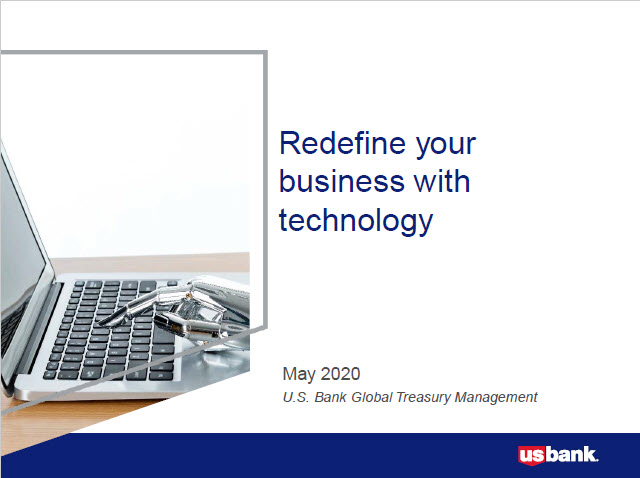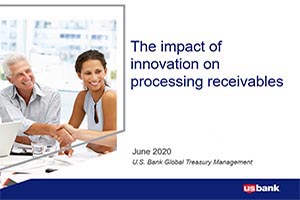Learn how artificial intelligence could benefit your organization’s account receivables process.
After focusing on payables automation for many years, corporate treasury managers are starting to turn their attention to receivables automation. Amid the evolution from paper to electronic payments, one technology that’s starting to make a difference is artificial intelligence (AI).
Banks – some partnering with financial technology companies (fintechs) – are beginning to develop intelligent accounts receivable (A/R) platforms. The goal of these AI-supported platforms is to make the manual, time-intensive work of cash application more efficient. This can free up A/R staff for more strategic duties.
A pain point
Cash application has traditionally been a pain point for the A/R function. Matching payments with specific customer invoices can require manual effort and research time.
In the days when paper payments dominated, banks addressed this pain primarily through enhancements to lockbox services. These enhancements can relieve the research burden related to paper payments through data capture and data entry. But even banks sometimes find this to be an uphill battle, particularly on the data capture front. This is due to the lack of consistency among payers, few industry standards for formatting invoices and the absence of remittance detail.
Indeed, using intelligent or optical character recognition technologies to automate the capture of invoice numbers or amounts due can be problematic and lead to inaccurate data collection.
While it seems counterintuitive, the pains of cash application have been exacerbated by the growing migration to electronic payments. Remittance information related to electronic payments is often delivered separately: sometimes in email messages, attachments, or through web portals. A/R staff are left to do the painstaking research required to reconcile the payment with the remittance information.
The evolution from paper to electronic payments has brought new challenges. Cash application for many businesses remains an inefficient and costly enterprise.
“Typically, the mantra among a company’s cash management team has been: ‘Let’s collect cash as quickly as we can and then figure out how to apply it later,’” explains Lucy Diasio, group product manager of integrated receivables and e-payments at U.S. Bank. “And if that means accounts receivable needs to add people and overtime to apply cash, then so be it.”
Integrated receivables
Today, many banks are helping organizations address the challenges of multiple payment types – and the cash application difficulties related to electronic payments – by offering integrated receivables solutions.
These solutions allow organizations to manage an array of incoming payment types – both paper and electronic – and associated remittance data through a single online portal. From a reporting perspective, treasury managers would then receive a holistic view of all their payments.
In addition, integrated receivables platforms can assist with cash application. They introduce tools, such as business rules and data enrichment, to automate the manual processes required to manage payment exceptions and reporting. And they can be set to manage certain exceptions automatically while routing others, that can’t be automated, for further review.
However, with integrated receivables solutions, there’s still some level of manual intervention involved in matching some payments to their remittance data.
Bringing AI to bear
That's where artificial intelligence comes into play. Banks and their fintech partners are developing receivables solutions that harness AI to offer businesses productivity gains in cash application processing. These intelligent receivables combine data aggregation, data correction and A/R matching processes to improve straight-through reconciliation of incoming payments.
New platforms, supported by AI and machine learning, are being designed to identify payers and associate their payments to remittances that are received separately. Here’s what they can do:
- Extract remittance data from emails, email attachments, electronic data interchange (EDI) and payer web portals.
- Match payments to open receivables using the enriched remittance data.
- Create receivables posting files that an organization can upload to its enterprise resource planning (ERP) system.
Benefits of automating cash application
For organizations that manage a large volume of payments – where the remittance information is either missing or provided separately from the payment – there are many advantages to automating the cash application process. Probably the biggest one is reducing the need to research exceptions. These are transactions where there is no immediate match between a payment and corresponding remittance information. Many A/R staff hours can be spent on this research. And automating cash application to a greater degree can enable a company to reallocate those staff hours to more strategic use.
“We had one client who discovered they had nearly half of their customers taking unearned prompt-pay discounts, costing their company almost $2 million a year,” says John Melvin, a working capital consultant at U.S. Bank. “The problem was the company’s A/R clerks were focused exclusively on manually applying every invoice. Their job was to key data – not to red flag when a customer was 20 days late and taking a 2 percent discount.”
In the future, by employing AI-supported receivables platforms, companies like this one would be in a better position to have A/R staff spend their time reviewing exceptions and monitoring data analytics, rather than just keying data. This would enable them to monitor customer adherence to payment terms and generally have better information for managing A/R.
“Artificial intelligence and machine learning excel at finding patterns and anomalies in large data sets that humans easily miss or spend significant effort researching. Augmenting your workforce with artificial intelligence can help you do more with less,” says David Berglund, Artificial Intelligence leader at U.S. Bank.
Faster, more efficient cash application processing also could improve cash flow, reduce days sales outstanding (DSO), and cut down on write-offs and the need to return unmatched payments. It could also improve customer relations.
“Instead of a lot of calls between vendors and customers being about payments that are missing or have yet to be applied, those conversations can become more strategic and value-added,” Melvin notes.
Stay tuned as the opportunities and benefits of applied AI emerge for your organization.






























































































